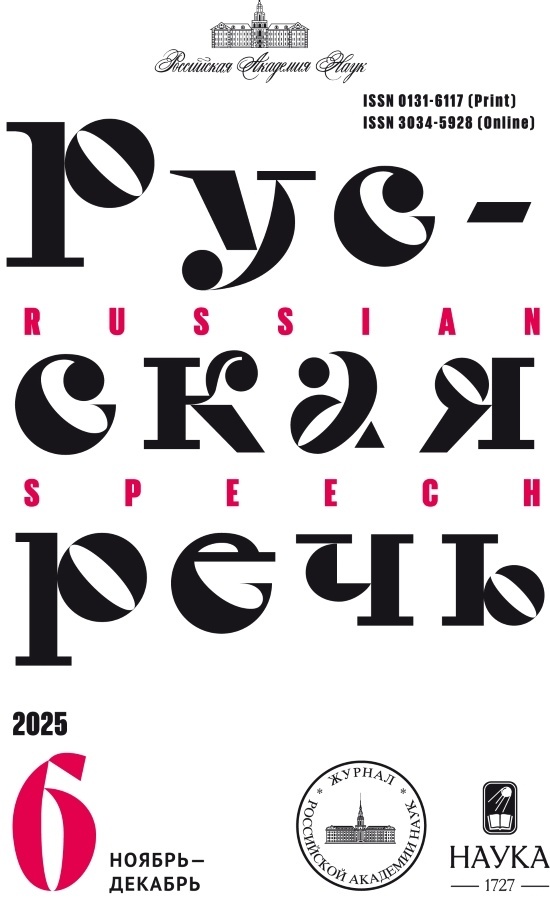Stylistic Similarities and Differences of Russian Interwar Novels Through the Prism of the Most Frequent Words
- Autores: Dviniatin F.N.1, Kovalev B.V.1
-
Afiliações:
- Saint Petersburg State University
- Edição: Nº 6 (2025)
- Páginas: 111-127
- Seção: The Language of Fiction
- URL: https://journals.eco-vector.com/0131-6117/article/view/696187
- DOI: https://doi.org/10.31857/S0131611725060082
- ID: 696187
Texto integral
Resumo
The article deals with the analysis of the most frequent words in the corpus of Russian interwar prose. The starting point is a stylistic analysis using one of the most tested and reliable stylistic tools, Burrows's Delta, with the help of which we performed the clustering of the interwar period novels. Within the framework of this article, it is proposed to analyze the most frequent words in these novels and compare the results with the Delta data. Particular attention is paid to grammatical categories, the study of features directly expressed in frequency of word usage. The objective is to identify what the frequency of these features can say about the stylistic features of the analyzed texts; their similarities and differences. For this purpose, we introduced the concepts of high, neutral and low frequency of a word in a certain text. Based on the calculations, it is found that the styles of Shmelev and Pilnyak are sharply marked, for all 25 words the frequency level coincides in Leonov's "Road to the Ocean" and "Skutarevsky". The results also allow us to record the competition of prepositions, conjunctions and pronouns. None of the texts examined has a combination of equally high or equally low proportions of the prepositions "v" and "na". In addition, it is concluded that the high frequency of "kak" correlates with the metaphorical poetics of Olesha, five later novels by Nabokov, Fedin, Shmelev and Green, and that the abundance of the pronoun "ty" marks texts with a large role of dialogue and the informal, unofficial nature of this dialogue (Gaidar, Leonov, Platonov). The frequency of the pronoun "ona" is globally associated with the high role of the heroines in the narrative, but it turns out that the level of frequency for "The Shining World" is significantly higher than for "Running on the Waves".
Palavras-chave
Sobre autores
F. Dviniatin
Saint Petersburg State University
Autor responsável pela correspondência
Email: f.dvinyatin@spbu.ru
Saint Petersburg
B. Kovalev
Saint Petersburg State University
Email: bvkovalev@yandex.ru
Saint Petersburg
Bibliografia
- Андреев В. С. Моделирование индивидуального стиля американских поэтов-романтиков // Вестник Тамбовского университета. Серия: Гуманитарные науки. 2012. No 10. С. 47-52.
- Андреев В. С., Павлова Л. В., Романова И. В. Поэтика цвета "cattleya labiata" в лирике Владимира Набокова // Новый филологический вестник. 2021. No 3 (58). С. 214-224.
- Артемова О. Г. Языковые ключи к английской литературе от Шекспира до Фаулза. Воронеж: Наука-ЮНИПРЕСС, 2020. 596 с.
- Введенский А. М. Частотность предлога "на" в древнерусских текстах // Древняя Русь. Вопросы медиевистики. 2013. No 3 (53). С. 26-27.
- Двинятин Ф. Н., Ковалев Б. В. "Сирин не уступает Леонову": метод Delta для стилеметрического анализа русских романов межвоенного периода // Шаги / Steps. Т. 10. No 3. 2024. С. 207-229.
- Зевахина Т. С., Филиппова М. М. Об одном маркемологическом исследовании художественных текстов, или Можно ли свести четыре века английской литературы к двум ключевым словам // Вестн. Моск. ун-та. Серия 9. Филология. 2024. No 1. С. 111-124.
- Кашкина А. В. Сравнительный маркемный анализ: проблемы и перспективы // Язык, коммуникация и социальная среда: сб. науч. трудов. Воронеж: Воронеж. гос. ун-т; Изд. дом Алейниковых, 2010. Вып. 8. С. 228-235.
- Кретов А. А., Катов М. В. Сквозь призму маркем: Н. В. Гоголь в ближайшем контексте русской литературы // Вестник ВГУ. Серия: Лингвистика и межкультурная коммуникация. 2009. No 2. С. 12-21.
- Кретов А. А., Фаустов А. А. Понятие маркемы и предварительные итоги маркемного анализа русской литературы // ВГУ. Серия: Лингвистика и межкультурная коммуникация. 2017. No 4. С. 16-31.
- Михеев М. Ю., Эрлих Л. И. Идиостилевой профиль и определение авторства текста по частотам служебных слов // Научно-техническая информация. Серия 2: Информационные процессы и системы. 2018. No 2. С. 25-34.
- Национальный корпус русского языка [Электронный ресурс]. URL: https://ruscorpora.ru (дата обращения: 06.12.2024).
- Орехов Б. В. Текст и перевод Владимира Набокова через призму стилеметрии // Новый филологический вестник. 2021. No 3 (58). С. 200-213.
- Burrows J. Delta: a measure of stylistic difference and a guide to likely authorship // Literary and Linguistic Computing. 2002. No 3 (17). Р. 267-287.
- Calvo Tello J. Delta inside Valle-Inclán: stylometric classification of periods and groups of his novels // Romanische Studien. 2019. No 6. P. 151-163.
- Eder M. Style-Markers in authorship attribution. A cross-language study of the authorial fingerprint // Studies in Polish Linguistics. 2011. No 6. Р. 99-114.
- Eder M., Rybicki J., Kestemont M. Stylometry with R: a package for computational text analysis // R Journal. 2016. No 1 (8). Р. 107-121.
- Lutoslawski W. The origin and growth of Plato's logic. London: Longmans, 1897. 548 p.
- Michéa R. Mots fréquents et mots disponibles. Un aspect nouveau de la statistique du langage // Les langues modernes. 1953. No 47. P. 338-344.
- Mosteller F., Wallace D. L. Inference in an Authorship Problem // Journal of the American Statistical Association. 1963. Vol. 58. No 302. Р. 275-309.
- Rybicki J., Eder M. Deeper Delta across genres and languages: do we really need the most frequent words? // Literary and Linguistic Computing. 2011. Vol. 26. No 3. P. 315-321.










